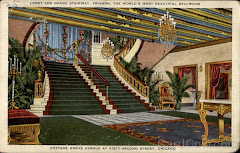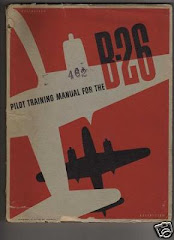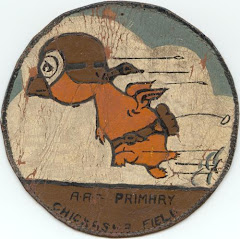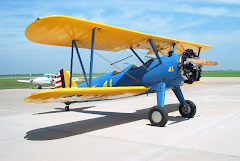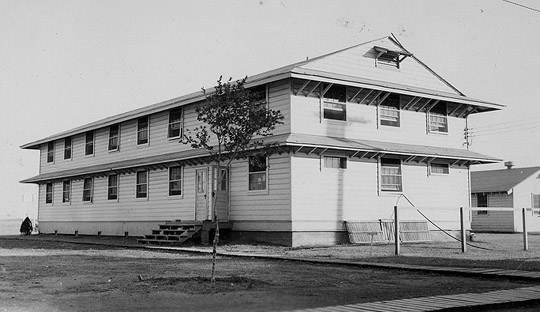Beginning to Fly – Meet the Fairchild PT 19
We learned to fly in the Fairchild PT 19 and the BC-1. The rugged little PT 19 was a one engine trainer aircraft. It had two open cockpits, the instructor sat behind you. It had plywood wings, fixed landing gear and flew at the phenomenal speed of about 130 mph! In truth, this was fairly slow for a light weight plane. The PT was also pretty stable, two positive factors for would-be pilots. Because of the open cockpit, the wind and colder temperatures the higher you flew, we were fitted out in two piece flying suits with fur collars, lined gloves, warm felt boots and leather helmets with goggles. (When we weren’t wearing the goggles, they were to be worn around our necks. Once we had completed our first solo flight we could wear them on our helmet.) Later, when we were overseas, our flying suits would have heated pants liners, heated jacket liners and heated gloves but for now we were so excited we didn’t notice the cold.
In addition to actual flying time every afternoon we were attending ground school and continuing our physical training during the first half of the day. We were also being thoroughly taught “military indoctrination” (the name of the course).
I was lucky to be assigned to a great instructor who stuck with me even though I was getting air sick just about every time I went up. I still remember my instructor’s name was William Dwyer. We were learning all the fundamentals: take offs, landings, forced landings, “s turns,” stalls, spins, loops etc. After about 24 hours of training with the instructor he told me to take my first “solo” flight which consisted of 3 or 4 take offs and landings. I was one of the first cadets in the class to do his solo and was quite proud to go back to the barracks wearing my goggles on my helmet.
The worst part of this training was when we started doing acrobatics. After training with the instructor for several days I would go up by myself and do several snap rolls, get sick, then go back and do it all over again. It took about forty hours of flying time before I got over the airsickness but it never bothered me again after that.
Tuesday, January 13, 2009
Monday, January 5, 2009
Chapter 9 Hallaleujah! Cadet School
I was first sent to an Army Air Corps base for recruits near Waco, TX. It was under construction at the time and after a few days, in March of 1942, we were sent to Kelly Field in San Antonio, TX for basic training. This lasted about six weeks. We did close order drill, took a lot of tests, did hours and hours of physical training and learned the usual Army routines. Weekends were for marching or parading.
We were billeted in tents while the base was under construction. They put us in alphabetical order and I became longtime friends with several men in my tent who had the same first letter in their last names. In addition to the tents, the base consisted of about 40 or 50 buildings that had recently been constructed to house classrooms, supplies, administration offices, residences for instructors, maintenance personnel, commissioned officers and noncoms and the Army Air Force Navigation School which had been transferred to Kelly from Barksdale Field.
Kelly was the training center for advanced aviation training of bomber pilots and crews. The demand for bomber crews had been escalating since Pearl Harbor and Kelly was a beehive of incoming cadets who would be trained to be navigators, bomber pilots or bombadiers as well as construction crews building almost as fast as new recruits arrived. But we weren’t ready for bomber school yet and as soon as we were through with basic training (April ’42) we were transferred out of Kelly. (A few months later, in July of ’42 it was renamed the San Antonio Aviation Cadet Center.)
Next we were sent to Chickasha, Oklahoma for primary flight training at the Wilson and Bonfils Flying School. Cadets had begun training to become U.S. Army Air Corps pilots there in October of 1941. More than eight thousand recruits trained to be aviators there during the four years that the school trained pilots for the Army. (Ironically, by 1944 Chickasha had also become home to a Prisoner of War camp for German soldiers.) My dreams of flying were beginning to come true.
We were billeted in tents while the base was under construction. They put us in alphabetical order and I became longtime friends with several men in my tent who had the same first letter in their last names. In addition to the tents, the base consisted of about 40 or 50 buildings that had recently been constructed to house classrooms, supplies, administration offices, residences for instructors, maintenance personnel, commissioned officers and noncoms and the Army Air Force Navigation School which had been transferred to Kelly from Barksdale Field.
Kelly was the training center for advanced aviation training of bomber pilots and crews. The demand for bomber crews had been escalating since Pearl Harbor and Kelly was a beehive of incoming cadets who would be trained to be navigators, bomber pilots or bombadiers as well as construction crews building almost as fast as new recruits arrived. But we weren’t ready for bomber school yet and as soon as we were through with basic training (April ’42) we were transferred out of Kelly. (A few months later, in July of ’42 it was renamed the San Antonio Aviation Cadet Center.)
Next we were sent to Chickasha, Oklahoma for primary flight training at the Wilson and Bonfils Flying School. Cadets had begun training to become U.S. Army Air Corps pilots there in October of 1941. More than eight thousand recruits trained to be aviators there during the four years that the school trained pilots for the Army. (Ironically, by 1944 Chickasha had also become home to a Prisoner of War camp for German soldiers.) My dreams of flying were beginning to come true.
Friday, January 2, 2009
Chapter 8 We Interrupt This Regularly Scheduled Program ...
It was about 2:30 in the afternoon before most of us in Texas started hearing about the attack on Pearl Harbor . You can’t imagine the shock and disbelief at the time, most of us had never heard of Pearl Harbor or even Hawaii
It was a Sunday. Most enlisted men had a few hours of free time on Sundays. If we could get a pass we were off the base. It didn’t matter where you were, even if you weren’t near a radio, word about the attack on Pearl Harbor spread like wildfire. We heard that every radio program was interrupted by a bulletin that the Japanese had attacked Pearl Harbor . New bulletins came in every few minutes.
All military were advised to return to their base as quickly as possible. We found out later that in 2 hours 18 ships, 188 planes and 2,403 men were lost at Pearl Harbor . President Roosevelt called a meeting of his cabinet. By nightfall, the West Coast was under blackout, expecting to be the next target of the Japanese. The next day FDR and congress declared war on Japan Germany
Monday, December 29, 2008
Chapter 7 I'm A Medic
I’m A Medic
Sometime in the fall of 1941 a team of recruiters from the Army Air Corps came by the base at Camp Barkeley asking for volunteers for Cadets for pilot training. I was first in line to volunteer. However, when I took the physical they dilated my eyes to the point I could hardly see, then I failed to pass the eye exam. Needless to say I was very disappointed and it was the first of many "mysteries" as to why the Army did what it did. It seemed pretty obvious that you couldn't take an accurate vision test if your pupils were dilated, so maybe you should take the vision exam first, then be dilated to check the eye itself. But what did I know, I wasn't a medic - yet.
So, it was back to my job as a typist at the hospital. Shortly however, I was “promoted” from being a typist to running the base dispensary! I would be giving new recruits their shots and hold daily sick call. Just the job I had tried to avoid for a year! I received a crash course in basic first aid, then advanced medical training. The dispensary consisted of a Captain who was in charge (he was also a Doctor), a Sergeant (me) and about six enlisted men.
One day we were supposed to give shots to about 200 soldiers at 0900 hours. The officers had marched the recruits over to the dispensary and lined them up outside the building. It was sunny and hot that day. We were not supposed to give shots without a Doctor being present. The Captain was late arriving. After about an hour with all of those soldiers standing in line outside in the hot sun, I decided we should start administering the shots. A short time later I heard the Captain come into his office, which was the room next to where we were working. About that same time a Major from the reception center barged into our room and said “I hear you’re giving shots without the presence of a Doctor.” I said, “No sir, the Captain is in the next room.”
Before too many weeks went by, the team of recruiters came around again asking for Cadet Volunteers. Again, I was first in line. This time I made sure they didn’t dilate my eyes during the physical. I passed the eye examination, as well as the physical, and was finally accepted into the Army Air Force Cadet program! It had been over a year since I first tried to get into pilot training at Randolph Field but it seemed like a lifetime.
Sometime in the fall of 1941 a team of recruiters from the Army Air Corps came by the base at Camp Barkeley asking for volunteers for Cadets for pilot training. I was first in line to volunteer. However, when I took the physical they dilated my eyes to the point I could hardly see, then I failed to pass the eye exam. Needless to say I was very disappointed and it was the first of many "mysteries" as to why the Army did what it did. It seemed pretty obvious that you couldn't take an accurate vision test if your pupils were dilated, so maybe you should take the vision exam first, then be dilated to check the eye itself. But what did I know, I wasn't a medic - yet.
So, it was back to my job as a typist at the hospital. Shortly however, I was “promoted” from being a typist to running the base dispensary! I would be giving new recruits their shots and hold daily sick call. Just the job I had tried to avoid for a year! I received a crash course in basic first aid, then advanced medical training. The dispensary consisted of a Captain who was in charge (he was also a Doctor), a Sergeant (me) and about six enlisted men.
One day we were supposed to give shots to about 200 soldiers at 0900 hours. The officers had marched the recruits over to the dispensary and lined them up outside the building. It was sunny and hot that day. We were not supposed to give shots without a Doctor being present. The Captain was late arriving. After about an hour with all of those soldiers standing in line outside in the hot sun, I decided we should start administering the shots. A short time later I heard the Captain come into his office, which was the room next to where we were working. About that same time a Major from the reception center barged into our room and said “I hear you’re giving shots without the presence of a Doctor.” I said, “No sir, the Captain is in the next room.”
Before too many weeks went by, the team of recruiters came around again asking for Cadet Volunteers. Again, I was first in line. This time I made sure they didn’t dilate my eyes during the physical. I passed the eye examination, as well as the physical, and was finally accepted into the Army Air Force Cadet program! It had been over a year since I first tried to get into pilot training at Randolph Field but it seemed like a lifetime.
Saturday, December 20, 2008
Chapter 6 Not A Medic, Please
A couple of days after our arrival at Fort Bliss an orderly came to our tent and asked if any of us could type. I said yes so they took me up to headquarters and gave me a typing test. Not too long after that I was reassigned to the Receiving Office of the Hospital at newly constructed Camp Barkeley, a few miles southwest of Abilene, Texas. So, even though I had refused to enlist in the medics at Randolph Field I wound up in the medics anyway. At least I was working a typewriter, not a hypodermic needle.
It was only two weeks after I was inducted at Fort Bliss, and events in Europe were looking grim. The famous Walter Winchell, whose radio commentaries included politics as well as celebrity gossip, was insisting America should enter the War – as were many other outspoken Americans. Daily radio broadcasts, both locally and nationally, told of the day’s war events in Europe. Even the National Farm and Home Hour, a popular radio broadcast in the Midwest, reported the progress of the war in Europe on every show. On May 27th, 1941 President Roosevelt went on the radio to announce that Germans had overrun Greece and Yugoslavia and invaded Crete. Europe was at War and it was beginning to look like America was going to eventually be drawn into the war. Getting ready for whatever would happen, Fort Bliss was busy training soldiers.
It was only two weeks after I was inducted at Fort Bliss, and events in Europe were looking grim. The famous Walter Winchell, whose radio commentaries included politics as well as celebrity gossip, was insisting America should enter the War – as were many other outspoken Americans. Daily radio broadcasts, both locally and nationally, told of the day’s war events in Europe. Even the National Farm and Home Hour, a popular radio broadcast in the Midwest, reported the progress of the war in Europe on every show. On May 27th, 1941 President Roosevelt went on the radio to announce that Germans had overrun Greece and Yugoslavia and invaded Crete. Europe was at War and it was beginning to look like America was going to eventually be drawn into the war. Getting ready for whatever would happen, Fort Bliss was busy training soldiers.
Saturday, December 13, 2008
Chapter 5 Joining the Army
For almost two years since I left Nebraska I’d worked different jobs, mostly hard labor. In March of 1941, I asked my brother to drive me the 35 or 40 miles into Fort Stockton in Pecos County Texas. I volunteered for the draft. The draft center put me on a bus to El Paso and I was finally inducted into the Army at Fort Bliss, on May 9, 1941.
I didn’t join the Army to “serve or defend my country” or to “fight for our freedom.” I’d spent about six years since graduating from high school eeking out an existence during the Depression and the years of drought. I’d been a dirt farmer and had worked from dawn to daylight, driving a tractor all day and most of the night, six days a week, sleeping on a cot at the end of the field I was farming. I’d worked on a cotton inspecting team following the harvest from South Texas to North Texas and into Arizona during the hottest, driest weather I’d ever experienced. I’d worked on a cattle ranch, waited tables at restaurants and stocked grocery shelves. I knew there was a better life out there and I wanted to use my brain, not my back. I’d spent a lot of time in farmland fields stopping to watch when a plane flew over. I’d dreamed of being a pilot and leaving dirt, dust and boll weevils far below in my own dust. When I joined the Army I wanted to be trained as a pilot. I wanted to get more education and be able to pursue a career. At the time, Europe was already under siege by Hitler but in America we had no notion that almost six months to the day from my induction into the Army Pearl Harbor would be attacked by Japan.
I didn’t join the Army to “serve or defend my country” or to “fight for our freedom.” I’d spent about six years since graduating from high school eeking out an existence during the Depression and the years of drought. I’d been a dirt farmer and had worked from dawn to daylight, driving a tractor all day and most of the night, six days a week, sleeping on a cot at the end of the field I was farming. I’d worked on a cotton inspecting team following the harvest from South Texas to North Texas and into Arizona during the hottest, driest weather I’d ever experienced. I’d worked on a cattle ranch, waited tables at restaurants and stocked grocery shelves. I knew there was a better life out there and I wanted to use my brain, not my back. I’d spent a lot of time in farmland fields stopping to watch when a plane flew over. I’d dreamed of being a pilot and leaving dirt, dust and boll weevils far below in my own dust. When I joined the Army I wanted to be trained as a pilot. I wanted to get more education and be able to pursue a career. At the time, Europe was already under siege by Hitler but in America we had no notion that almost six months to the day from my induction into the Army Pearl Harbor would be attacked by Japan.
Friday, December 5, 2008
Chapter 4 I'll Enlist If I can Be A Pilot
I first tried to enlist in the Army Air Corps at Randolph Air Force Base in Universal City, northeast of San Antonio, in late 1940. Randolph Field was a training base for pilots, so it seemed like the best place to go to enlist. When I got there I found out they were only accepting guys applying to be Mechanics or Medical personnel. Because I only wanted to be a pilot I decided not to enlist.
Two weeks later I reconsidered. I knew enough about fixing machinery that I decided to go back to Randolph and enlist as a mechanic. At least I’d learn how to fix airplanes and I thought that might be a good thing for a pilot to know. When I got there they didn’t need mechanics anymore. I still didn’t want to be a Medic, so again I didn’t enlist. The cotton season was over and jobs were hard to come by. I hitch-hiked to a small Texas town, Girvin, which was about 300 miles northwest of San Antonio. It was a couple of miles west of the Pecos river, where my oldest brother ran a nearby cattle ranch. I spent the winter as a cowboy helping him out on the ranch.
Two weeks later I reconsidered. I knew enough about fixing machinery that I decided to go back to Randolph and enlist as a mechanic. At least I’d learn how to fix airplanes and I thought that might be a good thing for a pilot to know. When I got there they didn’t need mechanics anymore. I still didn’t want to be a Medic, so again I didn’t enlist. The cotton season was over and jobs were hard to come by. I hitch-hiked to a small Texas town, Girvin, which was about 300 miles northwest of San Antonio. It was a couple of miles west of the Pecos river, where my oldest brother ran a nearby cattle ranch. I spent the winter as a cowboy helping him out on the ranch.
Subscribe to:
Posts (Atom)




